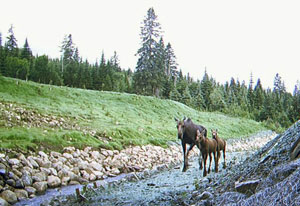Of moose and men
Country roads can be hazardous for moose and men. According to estimates, millions of vehicles collide with moose, elk and caribou in North America and Europe each year. Moose, in particular, venture to roadsides to lick the salt pools that collect following pavement de-icing.

Because moose are the largest animal in the deer family, with males weighing up to 720 kilograms, their salt cravings can pose significant risks to human and vehicle safety. That’s why a group of researchers has investigated ways to encourage moose away from roads.
The large mammals can adeptly recall the salt pools they visit in previous years, says lead author Paul D. Grosman, a graduate student in the Concordia Department of Geography, Planning and Environment. “When the scheduled time came to go to a salt pool, moose moved directly to it with purpose,” he explains. “Sodium concentration is two or three times higher in roadside salt pools compared to aquatic plants, yet those salt pools increase the probability of moose-vehicle collisions by 80 per cent.”
To avoid moose-man collisions, the best scenario is to completely remove roadside salt pools, Grosman stresses: “If compensation salt pools are used, they should be located as far as possible from the roads — beyond 500 metres.”

Grosman conducted his investigation with Concordia professors Jochen A.G. Jaeger and Pascale M. Biron, as well as colleagues from the Université du Québec à Rimouski and the Ministère des Ressources naturelles et de la Faune du Québec.
The research team focused on a portion of the Laurentides wildlife reserve, situated between Quebec City and Saguenay, which is traversed by two provincial highways.
Some 47 tagged moose were monitored for three years via Global Positioning System as they travelled, rested and foraged. A computer-animated control group of 40 moose served as a point of comparison.

The research team tested various scenarios, such as removing salt pools altogether or creating compensation salt pools. Although moose could travel as much as 10 kilometres to drink from salt pools, their road crossings could be reduced by as much as 79 per cent when all roadside salt pools were removed.
“The most effective management strategy is to remove all salt pools, without creating any compensatory ones, and let moose return to foraging for aquatic plants to satisfy their sodium dietary requirement,” says Grosman, noting that other costlier security measures include fencing highways or building wildlife underpasses.
- From May 24 to May 27, 2011, Jaeger and Grosman will take part in a French-language conference on large and small fauna in Quebec City called Routes et faune terrestre: De la science aux solutions. For more information, please consult the conference website.
Partners in research:
This study was funded by the Ministère des Transports du Québec, the Ministère des Ressources naturelles et de la Faune du Québec, the Université du Québec à Rimouski, the Fonds québécois de la recherche sur la nature et les technologies, the Natural Sciences and Engineering Research Council of Canada and Concordia’s J.W. McConnell Graduate Memorial Fellowship.
Related links:
• Cited research
• Concordia Department of Geography, Planning and Environment
• Ministère des Ressources naturelles et de la Faune du Québec
• Université du Québec à Rimouski
Source:
Sylvain-Jacques Desjardins
Senior advisor, external communications
Concordia University
Phone: 514-848-2424, ext. 5068
Email: s-j.desjardins@concordia.ca
Twitter: http://twitter.com/concordianews

